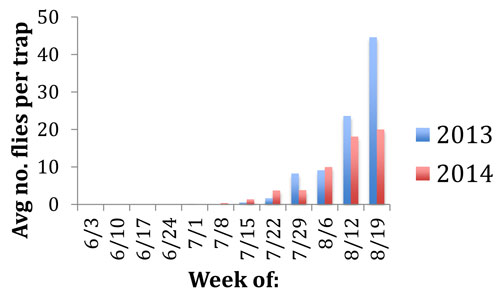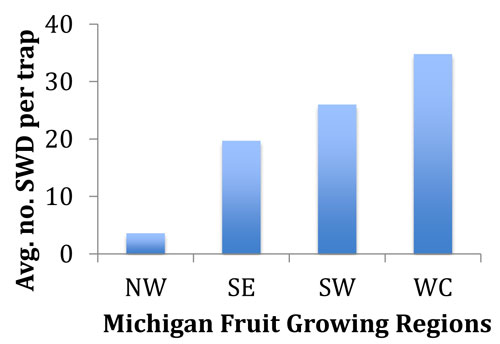Michigan spotted wing Drosophila report for August 19, 2014
Spotted wing Drosophila numbers continue to rise across the monitoring network. Protect susceptible crops where SWD are detected.
This is the ninth weekly report of the Michigan State University Extension spotted wing Drosophila (SWD) statewide monitoring program for 2014. Our network of traps across more than 100 sites was checked during the week of Aug. 12 and shows that SWD activity is continuing to increase. There was a total of 1,327 male and 658 female SWD trapped from all of the counties in our trapping network: Berrien, Van Buren, Allegan, Ottawa, Kalamazoo, Kent, Ionia, Montcalm, Oceana, Muskegon, Antrim, Leelanau, Grand Traverse, Benzie, Ingham, Genesee, Lapeer, Livingston, Macomb and Oakland.
Comparison of average trap catches by week between 2013 and 2014

Comparison of average SWD adults captured per trap by region. This week trapping is reported from 30 sites in the northwest (NW) counties of Antrim, Benzie, Grand Traverse, and Leelanau; 9 sites in the southeast (SE) counties of Ingham, Genesee, Lapeer, Livingston, Macomb, and Oakland; 44 sites in the southwest (SW) counties of Allegan, Berrien, Kalamazoo, Ottawa, and Van Buren; and 16 sites in the west central (WC) counties of Ionia, Kent, Montcalm, Muskegon, and Oceana.
Of the traps that were checked this week, 86 percent of traps contained SWD, which is up from 68 percent last week. The average number of SWD per trap is also up slightly from 18 last week to 20 this week across the network. SWD averages per trap still remains low in traps placed in the four northwest counties, with only four flies caught per trap on average. If SWD has not been found in your monitoring traps, be on alert for this pest as susceptible fruit crops start or continue to ripen as the mid-late summer increase in population is underway in most of the state. Susceptible crops include most thin-skinned fruit, such as strawberries, raspberries, blueberries and cherries.
SWD can only infest fruit when they are ripening or ripe, so the focus of SWD monitoring and management efforts should be in susceptible fruit that should be treated only if SWD are detected to minimize the risk of developing pesticide-resistant populations of SWD. In addition to the use of monitoring traps to detect the adult flies, a simple salt solution of 1 cup of salt per gallon of water can be used to assess fruit for larval infestation. Leave the fruit in the solution for a minimum of 15 minutes then check for small white larvae.
When adults are found, new generations are being produced every one to three weeks, depending on weather conditions, with warmer weather – between 68-80 degrees Fahrenheit – shortening the interval between generations. For more information on SWD monitoring and management strategies, and to read past reports, visit MSU‘s Spotted Wing Drosophila website.
The weekly SWD statewide monitoring report has been funded through Project GREEEN and Michigan State University Extension. This output is generated through a network of MSU Extension field staff and campus specialists. We would like to acknowledge the following team members and thank them for their weekly scouting efforts and input into this report: Rufus Isaacs, Keith Mason, Steve VanTimmeren, Larry Gut, Peter McGhee, Michael Haas, Bob Tritten, Mark Longstroth, Brad Baughman, Carlos Garcia, Karen Powers and Nikki Rothwell.
Dr. Isaacs' work is funded in part by MSU's AgBioResearch.



 Print
Print Email
Email




